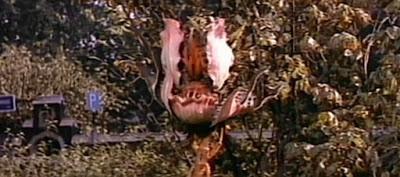Format: Streaming video from Tubi TV on the new internet machine.

A good storyteller can make just about anything scary. Some things are certainly harder than others; Night of the Lepus demonstrated that. So what about killer plants? Invasion of the Body Snatchers sits on one end of the “scary plant” continuum with probably Attack of the Killer Tomatoes on the other end. Somewhere in the middle is Little Shop of Horrors, and right along the same line is The Day of the Triffids (sometimes called Invasion of the Triffids. Our creatures are killer man-eating plants from outer space, more mobile than Audrey II, and without the luxurious singing voice.
The film opens with a little backstory on carnivorous plants and introduces us to the triffids, which (in the movie, not the book) crash landed on Earth on a meteor. Triffids can grow to seven feet high or so, and are capable of uprooting themselves and “walking.” This characteristic is interesting, because it brings up something that’s important to talk about before we get into the story aspects of this: influence.
Naturally, The Little Shop of Horrors is a first thought here. For what it’s worth, Roger Corman’s movie came out first, but the book on which The Day of the Triffids is based was published before Corman’s movie came out. There seems to be a little bit here in grade-Z movie The Creeping Terror as well, if only in the shuffling gait of the giant plants. But this just scratches the surface. 28 Days Later references this with Jim’s awakening in an abandoned hospital. There’s a great deal in Night of the Comet from this movie’s deadly meteor shower. And, the way the Triffid move and congregate certainly puts the audience in mind of just about every zombie movie ever made.
The Day of the Triffids is actually two movies rolled into one, or a movie with two separate plots and characters. Our secondary plot takes place in a lighthouse off Cornwall. Drunken but otherwise talented scientist Tom Goodwin (Kieron Moore) and his long-suffering wife/assistant Karen (Janette Scott) are trapped by the Triffids and spend the film fighting with each other and looking for ways to kill the creatures. Tom spends a lot of time yelling at his wife and complaining that the ship hasn’t arrived to either bring them home or bring him another bottle of whiskey.
The main story takes place initially in England, but then moves to the continent, from France down to Spain. Bill Masen (Howard Keel) is a merchant marine officer who has had surgery on his eyes. Because of this he misses a massive, spectacular meteor shower. This turns out to be a good thing, because that meteor shower causes two important events. The first is that it seems to empower the triffids to become mobile and start attacking and eating people. The second is that the meteors blind everyone who watched them. The reasons for this is not explained, but we find out that pretty much the entire population of Europe has been blinded—everyone went to look at the meteors.
Bill finds his way around London and eventually rescues a young girl name Susan (Janina Faye) from a train crash. Susan also missed the meteor shower and is able to see. The two head for the coast and Bill’s ship, and eventually make their way to France. Here they find a chateau with a f couple of sighted people, notably Christine Durant (Nicole Maurey) and about three dozen or so people blinded by the meteor shower. This proves to be a sort of haven for a few days until the triffids start moving in. Worse, while Bill is out, a group of convicts—all sighted because they were in cells while the meteor shower passed—have broken into the house and are causing mayhem. Like I said, there’s some real zombie movie energy here. And, true to zombie movie form, Bill, Susan, and Christine manage to leave the house just as a horde of triffids comes in and kills everyone, including Bettina (Carole Ann Ford), who had all the hallmarks of “sentimental and likely survivor” stamped all over her.
Anyway, much of this plot is about getting back to the coast and making contact with the military, specifically some submarines that were underwater when the meteors struck. The two plots never cross—no one from the lighthouse ever shares the screen with anyone outside of the lighthouse. What this means is that when one group figures out what kills the triffids (and boy is it a dumb thing), there’s no way to tell anyone else.
The Day of the Triffids has, and I mean this exactly as I say it, some of the worst special effects and rear projection I have seen in a long time. At one point, there is an airplane that we are going to follow all the way to the scene of the crash (everyone on board is blind, including both pilots). It is the fakest crash I have ever seen, and I’ve seen movies that use bathtub toys to represent submarines. It takes something away from the seriousness of the moment when the plane crash appears to have been engineered by Billy, age 6.
I did want to like this more than I do. It’s just not that good. It feels like three movies—the couple in the lighthouse, dealing with the triffids, and everyone going blind. At least one of those could have easily been dropped.
Why to watch The Day of the Triffids: SCIENCE! saves the day!
Why not to watch: On paper, it’s in Night of the Lepus territory.
